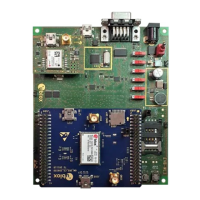SARA-R5 series - System integration manual
UBX-19041356 - R04 Design-in Page 89 of 118
C1-Public
2.6.4 SDIO interface
☞ The SDIO interface is not supported by the “00” product version of SARA-R5 series modules.
☞ Accessible test points directly connected to the SDIO_D0, SDIO_D1, SDIO_D2 and SDIO_D3 pins
may be provided for diagnostic purpose, alternatively to the highly recommended test points on
the USB interface pins.
2.6.5 DDC (I2C) interface
2.6.5.1 Guidelines for DDC (I2C) circuit design
☞ Communication with an external GNSS receiver is not supported by SARA-R510M8S modules.
The DDC I2C-bus master interface can be used to communicate with u-blox GNSS receivers and other
external I2C-bus slaves as an audio codec.
The SDA and SCL pins of the module are open drain output as per I2C bus specifications [10], and they
have internal pull-up resistors to the V_INT 1.8 V supply rail of the module, so there is no need of
additional pull-up resistors on the external application board.
☞ Capacitance and series resistance must be limited on the bus to match the I2C specifications
(1.0 s is the max allowed rise time on SCL and SDA lines): route connections as short as possible.
☞ ESD sensitivity rating of the DDC (I2C) pins is 1 kV (HBM according to JESD22-A114). Higher
protection level could be required if the lines are externally accessible and it can be achieved by
mounting an ESD protection (e.g. EPCOS CA05P4S14THSG varistor) close to accessible points.
Connection with u-blox 1.8 V GNSS receivers
☞ Communication with an external GNSS receiver is not supported by SARA-R510M8S modules.
Figure 67 shows a circuit example for connecting the cellular module to a u-blox 1.8 V GNSS receiver:
• The SDA and SCL pins of the cellular module are directly connected to the related pins of the u-blox
1.8 V GNSS receiver. External pull-up resistors are not needed, as they are already integrated in the
cellular module.
• The GPIO2 pin is connected to the active-high enable pin of the voltage regulator that supplies the
u-blox 1.8 V GNSS receiver providing the “GNSS supply enable” function (see section 1.11). An
additional pull-down resistor is provided to avoid a switch-on of the positioning receiver when the
cellular module is switched off or in the reset state.
• The GPIO3 pin is directly connected to the TXD1 output pin of the u-blox 1.8 V GNSS receiver
providing additional “GNSS data ready” function (see section 1.11), which is suitable for power
consumption optimization.
• The GPIO4 pin is directly connected to the EXTINT input pin of the u-blox 1.8 V GNSS receiver,
implementing the additional optional “External GNSS time stamp of external interrupt” function
(see section 1.11), which is suitable for timing features.
• The SDIO_CMD pin is directly connected to the TIMEPULSE output pin of the u-blox 1.8 V GNSS
receiver, implementing the additional optional “External GNSS time pulse” function (see section
1.11), which is suitable for timing features.

